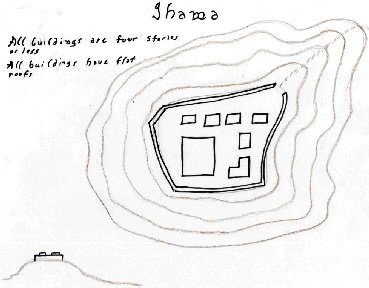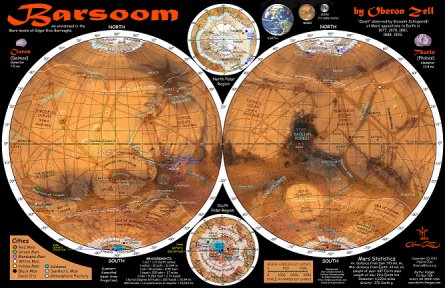
Official Edgar Rice Burroughs Tribute Weekly Webzine Site
Since 1996 ~ 15,000 Web Pages In Archive
Volume 4141
THE FORTRESS OF JAHMA
By Rick Johnson

Located in the Great Wasteland between Jahar and Tjanath, Jhama is mentioned only in one novel, A Fighting Man of Mars, though it plays a pivotal role in the war between Jahar and Helium.
Cartography by Rick JohnsonOur first sight of the fortress comes from a description by Tan Hadron who is drifting eastward with Nur An over the desert in his home-made hot-air balloon after escaping Ghasta which he entered after escaping Tjanath. Tan Hadron describes the fortress thus:“As we topped a low hill, passing over it by a scant fifty sofads we saw below us a building of gleaming white. Like all the cities and isolated buildings of Barsoom, it was surrounded by a lofty wall, but in other respects it differed materially from the usual Barsoomian type of architecture. The edifice, which was made up of a number of buildings, was not surmounted by the usual towers, domes and minarets that mark all Barsoomian cities and which only in recent ages have been giving way slowly to the flat landing stages of an aerial world. The structure below us was composed of a number of flat-roofed buildings of various heights, none of which, however, appeared to rise over four levels. Between the buildings and the outer walls and in several open courts between the buildings, there was a profusion of trees and shrubbery with scarlet sward and well kept paths. It was, in fact, a striking and beautiful sight, yet having so recently been lured to near destruction by the beauties of Hohr and the engaging allurements of her beautiful women, we had no mind to be deceived again by external appearances. We would float over the palace of enchantment and take our chances in the open country beyond.”Ok, the fortress was obviously old, predating aviation which was developed some 900 years before the incidents of Fighting Man. It is small, obviously too small for a city or even a town. And it is placed in the desert far from any city. It is described as being 2900 Haads from the Otz Mountains, 1500 Haads from Tjanath and 2500 Haads from Jahar.Later in conversation with the exiled scientist, Phor Tak we learn:
“He told us the story of his wanderings after he had left Jahar and of how he had stumbled upon this long deserted castle, whose builder and occupants had left no record other than their bones. He told us that when he discovered it skeletons had strewn the courtyard and in the main entrance were piled the bones of a score of warriors, attesting the fierce defense that the occupants had waged against some unknown enemy, while in many of the upper rooms he had found other skeletons-- the skeletons of women and children.”So the place was attacked and looted by a (supposed) Green Hoard and then forgotten. What we know now is that the citadel was inhabited by soldiers, women and children. As for its name, Phor Tak called it Jhama as he lacked any records of the true identity of the place.
"I believe," he said, "that the place was beset by members of some savage horde of green warriors that left not a single survivor. The courts and gardens were overgrown with weeds and the interior of the building was filled with dust, but other ise little damage had been done. I call it Jhama, and here I am carrying on my life's work."From now on we must play archaeologist and make assumptions based upon what we see.

Drawing of Jhama by R. JohnsonFirst of all it is placed upon a hill in the desert between Jahar and Tjanath. This implies some sort of military border fortress. But whose?
TJANATH
Jahar is one of the older Empires, Tjanath an ancient city-state. Both are at odds as when Tan Hadron visits Tjanath, he is sentenced to The Death partly out of fear that he is an agent of Jahar. It is obvious that Jahar is the stronger as Tjanath is small and composed of only a single city and perhaps a few (unmentioned) outlying towns. Its position indicates that it has no Waterways so was never important enough to receive one, though its presumed proximity to the River Iss makes the Waterway redundant. At least there is an underground river that runs from Tjanath to Ghasta and one which Tan Hadron presumes joins with the Iss. So Tjanath depends upon wells for her water.The fact that Jahar can actually steal the Princess of the city and get away with it shows how weak Tjanath is in relation to Jahar. At least, it took Tan Hadron less than hours to figure out that Tul Axter had kidnapped Sanoma Tora but decades later, Tjanath still is unable to trace Tavia’s abductors. Or, if they did, were not powerful enough to go to war over her abduction.
Considering this, it would be a god idea for Tjanath to build a fortress between themselves and Jahar as an early warning system.
JAHAR
Jahar is an ancient empire, one of the largest. Waterways lead to and from it, it has large fertile farmlands and can support and protect massive unwalled areas such as U-Gor and (implied) others.Yet, on a dying world, all that land must be protected from both Green Hoards (Torquas and maybe the Thurid are nearby) but also other Red Cities hungry for her resources. Thus a series of advance warning fortresses surrounding the Empire would be a good idea. And if Jahar raids Tjanath with any frequency, then a Midway-post would give the raiders a resting point in such a trackless desert when thoat-back is the only way t travel.
HISTORY
Based on those thoughts, here is what we can deduce.Sometime more than a thousand years ago, either Jahar or Tjanath built the fortress now known as Jhama as an early warning site. I am guessing that back then, Jahar stretched far into the desert and Jhama was built to protect farmlands from the Green Hoards. Considering the distance and dangers of the desert between Jahar and Jhama (or even Tjanath and Jhama) duty there was a long-term affair so the soldiers would bring their families for company. Jhama was isolated and for the most part, forgotten save for those people who were stationed there and their reliefs.
Then, some centuries ago, disaster struck. Someone raided the place and killed everyone within. If an enemy city attacked, they would have taken the women and children as slaves so the bodies of these people found in the higher, better defended areas indicates that a Green Hoard raided the fortress, climbed the walls or found the gate left open and simply massacred everyone inside. Once the defenders and family were dead, the Hoard looted the place of everything of value and left the rest to rot in the desert.
The grass and crops grown within were trampled and taken and the fortress was simply abandoned. A relief column may have arrived shortly afterwards but fearing the nearby Hoard, returned to their home without even taking time to bury the dead. They probably took the most important military papers, burned the rest and ran for home hoping to get there before the Green Hoard caught them in the open desert, knowing that Jhama was taken once and could be taken again as easily.
And so Jhama remained, to gather dust, awaiting Phor Tak who found it in his wanderings.
And this is why I believe that Jhama was a Jahar fortress. The Great Waste is a big place with no water so why would Phor Tak head west? Why not north into more fertile areas? I believe that he knew that Jahar had a fortress there, one long abandoned and mentioned only in history books. Had Jhama been a Tjanath fortress, Tjanath would have returned to rebuild it as an early warning for Jahar’s recent military build-up. But if Jhama was Jahar, then it would be empty and safe for Phor Tak to take over. To Tul Axter, Jhama was only a footnote in a history book so why look there? Why rebuild a desert fortress when he could take Tjanath by air in a few days of war? Why remember Jhama?
No, Jhama was an ancient abandoned Jahar castle no different from many of the French and German castles on the border, noted on maps but largely forgotten. Phor Tak remembered the notation when he left in exile and chose to seek and find Jhama for his base of operations. Its location (far from Jahar yet close enough and ignored and forgotten) made it perfect for his aims.
JHAMA TODAY
Since the events of Fighting Man occurred about 1925, it has been almost 90 years since Tan Hadron’s visit. So what happened?First of all, Phor Tak arrived to find a forgotten ancient fortress. He took only a dozen or so fanatically loyal slaves, but no warriors, no fliers, no way to leave. He was stuck there and really had no intention of ever leaving Jhama. He intended to remain in Jhama until he died. Tul Axter returned only because he knew that Phor Tak was there, but he was running for his life and probably told no one. Tan Hadron found it by accident and after killing Phor Tak, left in a hurry for fear of being killed by the slaves. He would have no reason to return. Nur An, his companion would have returned to Jahar and forgotten about that place for fear of being killed by the slaves as an accessory in the killing of Phor Tak. Tavia had no desire to return, now happy married to Tan Hadron in Helium or Tjanath as their new Queen. So Jhama would have returned to obscurity. Inhabited only by a dozen forgotten slaves.
Forgotten by the Green Hoards, ignored by Helium, Jaher and Tjanath, Jhama is safe. The Red Men are a long-lived race and the slaves had replanted the grass and crops so could live a decent life there. Ninety years later, they may have even increased their numbers. But they also had a complete machine shop, remember that they built within weeks an invisible flier, and the training to build aircraft. They may not have had Phor Taks main inventions of the disintegrating ammunition and invisibility paint, but maybe there were other things there of value? Regardless, after assisting Tan Hadron and Nur An to build a flier, and having built the Flying Death, they now know how to build aircraft and so their isolationism would be chosen, not enforced. The former slaves would never become a city-state, the desert is too harsh, but they could build a flier, visit and trade for weapons and goods and defend themselves from some attacks.
Being so isolated, neither Jhar nor Tjanath would see any reason to retake the fortress, and if the Green Hoards stayed away, the slaves of Jhama would live a decent life, in peace.

GUIDE TO ALL THE RICK JOHNSON
ARTICLES AND FICTION IN ERBzine
ERBzine 1645
END
Barsoom Cartography by Oberon Zell
![]()

![]()
BILL
HILLMAN
Visit
our thousands of other sites at:
BILL
AND SUE-ON HILLMAN ECLECTIC STUDIO
ERB
Text, ERB Images and Tarzan® are ©Edgar Rice Burroughs, Inc.-
All Rights Reserved.
All
Original Work ©1996-2013/2017 by Bill Hillman and/or Contributing
Authors/Owners
No
part of this web site may be reproduced without permission from the respective
owners.